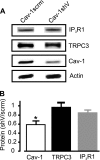Caveolin-1 assembles type 1 inositol 1,4,5-trisphosphate receptors and canonical transient receptor potential 3 channels into a functional signaling complex in arterial smooth muscle cells
- PMID: 21098487
- PMCID: PMC3039319
- DOI: 10.1074/jbc.M110.179747
Caveolin-1 assembles type 1 inositol 1,4,5-trisphosphate receptors and canonical transient receptor potential 3 channels into a functional signaling complex in arterial smooth muscle cells
Abstract
Physical coupling of sarcoplasmic reticulum (SR) type 1 inositol 1,4,5-trisphosphate receptors (IP(3)R1) to plasma membrane canonical transient receptor potential 3 (TRPC3) channels activates a cation current (I(Cat)) in arterial smooth muscle cells that induces vasoconstriction. However, structural components that enable IP(3)R1 and TRPC3 channels to communicate locally are unclear. Caveolae are plasma membrane microdomains that can compartmentalize proteins. Here, we tested the hypothesis that caveolae and specifically caveolin-1 (cav-1), a caveolae scaffolding protein, facilitate functional IP(3)R1 to TRPC3 coupling in smooth muscle cells of resistance-size cerebral arteries. Methyl-β-cyclodextrin (MβCD), which disassembles caveolae, reduced IP(3)-induced I(Cat) activation in smooth muscle cells and vasoconstriction in pressurized arteries. Cholesterol replenishment reversed these effects. Cav-1 knockdown using shRNA attenuated IP(3)-induced vasoconstriction, but did not alter TRPC3 and IP(3)R1 expression. A synthetic peptide corresponding to the cav-1 scaffolding domain (CSD) sequence (amino acids 82-101) also attenuated IP(3)-induced I(Cat) activation and vasoconstriction. A cav-1 antibody co-immunoprecipitated cav-1, TRPC3, and IP(3)R1 from cerebral artery lysate. ImmunoFRET indicated that cav-1, TRPC3 channels and IP(3)R1 are spatially co-localized in arterial smooth muscle cells. IP(3)R1 and TRPC3 channel spatial localization was disrupted by MβCD and a CSD peptide. Cholesterol replenishment re-established IP(3)R1 and TRPC3 channel close spatial proximity. Taken together, these data indicate that in arterial smooth muscle cells, cav-1 co-localizes SR IP(3)R1 and plasma membrane TRPC3 channels in close spatial proximity thereby enabling IP(3)-induced physical coupling of these proteins, leading to I(Cat) generation and vasoconstriction.
Figures








Similar articles
-
IP3 constricts cerebral arteries via IP3 receptor-mediated TRPC3 channel activation and independently of sarcoplasmic reticulum Ca2+ release.Circ Res. 2008 May 9;102(9):1118-26. doi: 10.1161/CIRCRESAHA.108.173948. Epub 2008 Apr 3. Circ Res. 2008. PMID: 18388325 Free PMC article.
-
Isoform-selective physical coupling of TRPC3 channels to IP3 receptors in smooth muscle cells regulates arterial contractility.Circ Res. 2010 May 28;106(10):1603-12. doi: 10.1161/CIRCRESAHA.110.216804. Epub 2010 Apr 8. Circ Res. 2010. PMID: 20378853 Free PMC article.
-
An elevation in physical coupling of type 1 inositol 1,4,5-trisphosphate (IP3) receptors to transient receptor potential 3 (TRPC3) channels constricts mesenteric arteries in genetic hypertension.Hypertension. 2012 Nov;60(5):1213-9. doi: 10.1161/HYPERTENSIONAHA.112.198820. Epub 2012 Oct 8. Hypertension. 2012. PMID: 23045459 Free PMC article.
-
The dynamic complexity of the TRPC1 channelosome.Channels (Austin). 2011 Sep-Oct;5(5):424-31. doi: 10.4161/chan.5.5.16471. Epub 2011 Sep 1. Channels (Austin). 2011. PMID: 21747233 Free PMC article. Review.
-
Transient receptor potential canonical type 3 channels: Interactions, role and relevance - A vascular focus.Pharmacol Ther. 2017 Jun;174:79-96. doi: 10.1016/j.pharmthera.2017.02.022. Epub 2017 Feb 14. Pharmacol Ther. 2017. PMID: 28223224 Review.
Cited by
-
Calcium signals that determine vascular resistance.Wiley Interdiscip Rev Syst Biol Med. 2019 Sep;11(5):e1448. doi: 10.1002/wsbm.1448. Epub 2019 Mar 18. Wiley Interdiscip Rev Syst Biol Med. 2019. PMID: 30884210 Free PMC article. Review.
-
Synapsin-Promoted Caveolin-1 Overexpression Maintains Mitochondrial Morphology and Function in PSAPP Alzheimer's Disease Mice.Cells. 2021 Sep 20;10(9):2487. doi: 10.3390/cells10092487. Cells. 2021. PMID: 34572135 Free PMC article.
-
Smooth muscle cholesterol enables BK β1 subunit-mediated channel inhibition and subsequent vasoconstriction evoked by alcohol.Arterioscler Thromb Vasc Biol. 2011 Nov;31(11):2410-23. doi: 10.1161/ATVBAHA.111.233965. Arterioscler Thromb Vasc Biol. 2011. PMID: 21868700 Free PMC article.
-
Transient receptor potential channels in the vasculature.Physiol Rev. 2015 Apr;95(2):645-90. doi: 10.1152/physrev.00026.2014. Physiol Rev. 2015. PMID: 25834234 Free PMC article. Review.
-
Caveolin-3 Overexpression Attenuates Cardiac Hypertrophy via Inhibition of T-type Ca2+ Current Modulated by Protein Kinase Cα in Cardiomyocytes.J Biol Chem. 2015 Sep 4;290(36):22085-100. doi: 10.1074/jbc.M115.674945. Epub 2015 Jul 13. J Biol Chem. 2015. PMID: 26170457 Free PMC article.
References
Publication types
MeSH terms
Substances
Grants and funding
LinkOut - more resources
Full Text Sources
Molecular Biology Databases
Research Materials
Miscellaneous

